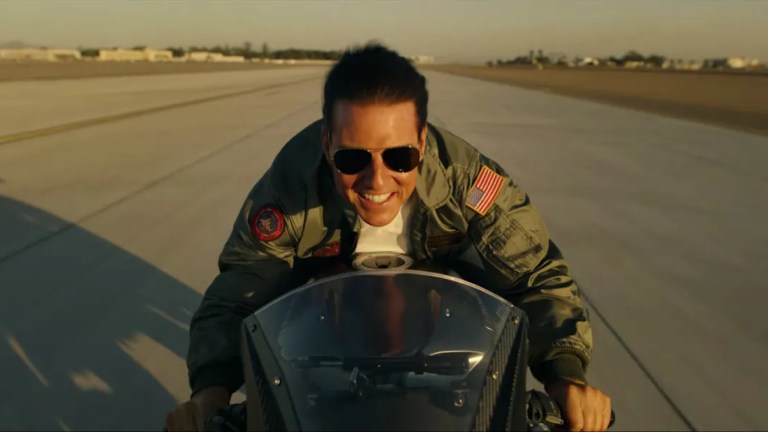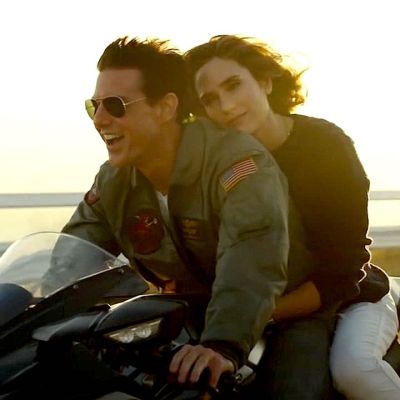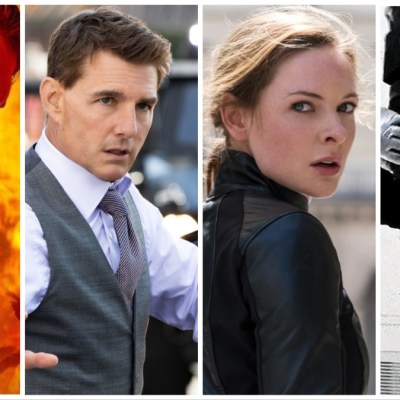What Top Gun: Maverick’s Historic Success Can Teach Hollywood
Top Gun: Maverick is smashing box office records left and right as it soars into its second week. So what are the takeaways from the Tom Cruise hit?

Top Gun: Maverick continues to be the rarest kind of ace in the box office skies after its second weekend. It’s of course hardly surprising the Tom Cruise-led legacy sequel maintained its perch as the number one movie in North America, as well as globally, following its historic Memorial Day weekend debut of $160 million in four days. And yet, it’s genuinely shocking just how small its drop-off from weekend to weekend actually was.
According to Paramount Pictures, Top Gun: Maverick grossed $90 million in its second weekend in the U.S. That number, which is also higher than any debut weekend for Cruise’s Mission: Impossible franchise, is down a mere 29 percent from its three-day haul last weekend of $126.7 million. For context, a decrease like this has never happened for a film that grossed north of $100 million in its opening weekend. The all-time opening weekend record-holder, Avengers: Endgame? That dropped 58.7 percent in its second weekend, which admittedly might’ve been due to it opening north of $350 million (the higher the box office the more potentially precipitous the fall). But Spider-Man: No Way Home, which like Top Gun: Maverick also received an “A+” CinemaScore rating from audiences, also fell more than 67 percent in its second weekend.
And even one of closest comparable legacy sequels, the generally beloved in its time Star Wars: The Force Awakens, saw a drop of 39.8 percent in its second weekend. That number is fantastic… but it’s still not 29 percent.
All of which is to say that the word of mouth for Top Gun: Maverick is dazzling. Beyond even the simple measurement of the picture’s coveted “A+” CinemaScore, this movie is demonstrating massive goodwill from an audience made up of a larger age-range than typical modern (read: Marvel) blockbusters. And those who went a week ago have clearly been recommending it to family and friends, and/or going back a second time themselves.
This is the type of box office smash that causes the industry to sit up and take notice—and invariably attempt to replicate that success in some way. And to be sure, there are lessons to be learned from Top Gun: Maverick’s reception. The question though is whether studios will land on the right takeaways from what is shaping up to be the feel-good movie of the summer.
Legacy Sequels Don’t Need to Just Be About a Legacy
The obvious element everyone will note about Top Gun: Maverick is it’s a legacy sequel. That is to say it is part of the already familiar trend of resurrecting a long-dormant franchise from yesteryear and sticking in a familiar face to capitalize on audience nostalgia. A cynic might even say it’s a fan-friendly way to remake a classic.
The term “legacy sequel” came into existence in the last seven years to describe the litany of movies in this vein, from the aforementioned The Force Awakens to Jurassic World, Creed, 2018’s Halloween, Terminator: Dark Fate, this year’s Scream and scores of others. (It’s notable that three of those aforementioned movies were in 2015 alone.)
So as the boffo success story that follows up on one of Cruise’s most beloved films from 36 years ago, Top Gun: Maverick appears to be more of the same at a glance. Except, it’s not.
When you really consider the term “legacy sequel,” it obviously speaks to the legacy of a popular property from yesteryear. But it also is indicative of how just about every one of these movies follows characters from a younger generation discovering (and often becoming appropriately awed by) iconic characters of the past. Star Wars, Jurassic Park, Terminator, and even arguably last year’s Spider-Man: No Way Home star young guns for younger audiences to latch onto who then also win over the older set by acting appreciative of how great their “parents’ Star Wars” (or their big brother’s Spider-Man) was.
Harrison Ford has come back to play Han Solo and Rick Deckard, but he’s always passing the proverbial torch to the next generation. In Top Gun: Maverick, Tom Cruise passes the torch to… Tom Cruise.
To be sure, Maverick introduces a new generation of talented fliers who are all gamely played by a winning and charismatic supporting cast: Glen Powell, Monica Barbaro, and Miles Teller all do superb work and, indeed, reenact a few key moments from the 1986 movie (and raise an honest question about why isn’t Powell a movie star already?). However, this movie is not told from their vantage; it’s told from Maverick’s.
Thirty-six years later, Cruise is determined to prove he’s still the biggest movie star on the planet. And you know what? He succeeds, as it was his intuition to make Maverick as visceral as it is (more on that below) and keep his character front and center. The younger generation earns their spurs, but as one of them mentions by the end of the film, “Maverick’s got five [kills]. That makes him an ace.” The classic isn’t going out of style here.
In that sense, it’s debatable whether Top Gun: Maverick is even a true legacy sequel or just a belated sequel to 1986’s Top Gun. The main character is the same nearly four decades on, and as it turns out with the right star and franchise, audiences may rather see their favorite prove he or she’s still got it rather than see them killed off or exit stage left to make way for newer characters. Somewhat related, this also suggests that at least in the realm of long-running franchises, even younger audiences do not mind seeing actors over the age of 40 like Cruise and Jennifer Connelly lead a movie, which also defies conventional Hollywood wisdom.
Audiences Still Like Strong, Standalone Stories
No matter how you classify it, Top Gun: Maverick is still a sequel. It might mark the biggest box office weekend in Cruise’s career (twice), but it’s also a follow-up on one of his most beloved roles and indeed one of the biggest movies of the 1980s. So it’d be fairly incredulous to suggest Top Gun: Maverick’s success means audiences are craving original stories.
However, it does appear that they miss strong, self-contained ones! A major part of the reason Top Gun: Maverick is hitting so big is the nostalgia of seeing Cruise in the cockpit of a fighter jet again and hearing Kenny Loggins croon about “the danger zone” during a montage of tough Navy guys on an aircraft carrier at sunset. But even as the movie hits many of the key moments older audiences can at least vaguely recall—beachside sports and a euphoric handshake in the third act—the way it goes about getting to them feels refreshingly different from anything else at the multiplex right now.
With an incredibly tight screenplay by Ehren Kruger, Eric Warren Singer, and Christopher McQuarrie (the latter of whom wrote or co-wrote the last three Mission: Impossible movies and Edge of Tomorrow), Top Gun: Maverick is a throwback to the type of blockbusters Cruise has always made: Crowdpleasers that rely on a degree of formula yet stay committed to telling a story with earnest conviction and a strong appreciation for classical structure.
Maverick’s emphasis on a strong character arc for its titular character, as well as broad but tangible ones for its supporting cast of archetypes, gives the movie a narrative propulsion lacking in so many modern blockbusters that have become glorified easter egg hunts and endless promotion for “the next one(s)” with setups for sequels and spinoffs, and endings more concerned about post-credits scenes than concluding this current story in a truly thrilling way. Maverick is also told without an ounce of self-deprecation or irony. As we’ve detailed here, the Marvel Studios formula which was perfected in 2012’s The Avengers has become the gold standard not only for Marvel but much of the industry at large that is attempting to duplicate that success.
As a consequence, most of these tentpole movies look and play the same, with a smirking wink toward the audience that undercuts any stakes with a joke or five that might make you laugh, yet also lowers the bar for the narrative to stick any kind of cathartic or emotional landing. Maverick doesn’t reinvent the wheel, obviously, and in fact one could argue its climax owes a lot to the original Star Wars and many of the WWII melodramas of the 1940s and ‘50s that inspired that. However, it fully commits to that melodrama with such precision and craft, from screenplay to Joseph Kosinski’s direction, that it is obviously hitting a sweet spot for audiences that’s gone underserved in the last decade.
Maverick does not set up sequels, a shared universe, or a streaming series, nor does it hit the same note all its blockbuster peers seek. It just lands this one story’s plane, and after a decade of interconnectivity and corporate brand-building that feels strangely exciting.
Sometimes the Old Ways Are Still the Best
Finally, in keeping with Cruise’s Mission: Impossible movies and a few other acolytes to the past, Top Gun: Maverick reminds us once again that live-action movies can be so much more satisfying on the big screen if the action is actually shot live. There is obviously a lot of visual effects and digital trickery involved in Maverick—for starters no valleys were leveled by military-grade precision missiles. And not every frame of aerial flying actually was captured in a camera.
… but a lot of it was. Most of it, in fact. As has been well-publicized for years, Cruise and the other actors in the film did something that no other aerial combat movie has ever attempted: they put IMAX cameras in the cockpit and captured real reactions in F/A-18 jets as the earth at 30,000 feet became their backdrop, and their planes were doing upward of 6.5Gs—that’s more force than what Neil Armstrong experienced when Apollo 11 was launched toward the moon.
When projected on the big screen, that kind of remarkable imagery and acting is unlike anything audiences have ever seen before… at least as captured in a camera instead of a computer. Of course the biggest movies of all time (sans inflation) rely heavily on computer generated imagery and what can be achieved by just having an actor stand in front of a blue screen. There’s no reason for that to go away.
However, as with the once-in-a-while success of James Bond pictures or most new Christopher Nolan joints, Top Gun: Maverick is a reminder that audiences hunger for the rare tactile quality. There’s nothing quite like seeing an actor or stuntman do something truly extraordinary onscreen. And yet, this fact apparently bears repeating every few years… So, as with Maverick himself, here it is again.
Top Gun: Maverick is playing in theaters now.


